Developing Professional Practice: HR Competencies and Group Dynamics
VerifiedAdded on 2021/02/20
|9
|2209
|55
Report
AI Summary
This report delves into the core competencies required for a successful HR professional, referencing the CIPD Profession Map to highlight essential knowledge, skills, and behaviors. It includes practical examples of how these competencies can be demonstrated. A self-assessment and SWOT analysis are conducted to evaluate the author's current capabilities, identifying strengths, weaknesses, opportunities, and threats related to their HR aspirations. The report further explores the dynamics of group behavior within an HR context, discussing the stages of team development (Forming, Storming, Norming, Performing, and Adjourning) and the impact of team roles as defined by Belbin. It addresses potential conflicts arising within teams and outlines effective conflict resolution methods, including the PEACE Communication Model, emphasizing the importance of communication, active listening, and strategic preparation to foster positive outcomes. The report concludes by providing a list of references, including books and journals related to professional identity, team dynamics, and conflict resolution in an HR setting.
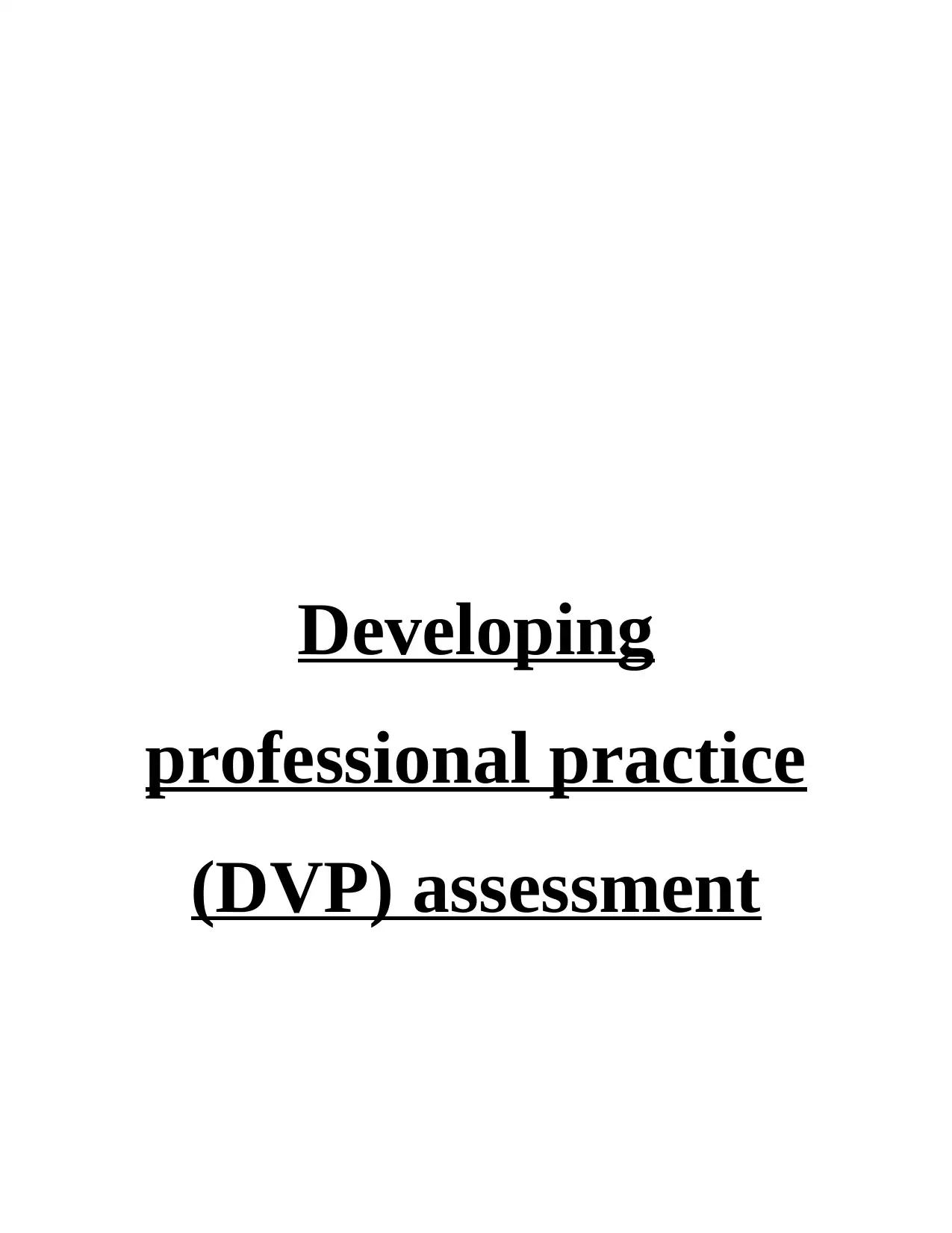
Developing
professional practice
(DVP) assessment
professional practice
(DVP) assessment
Paraphrase This Document
Need a fresh take? Get an instant paraphrase of this document with our AI Paraphraser
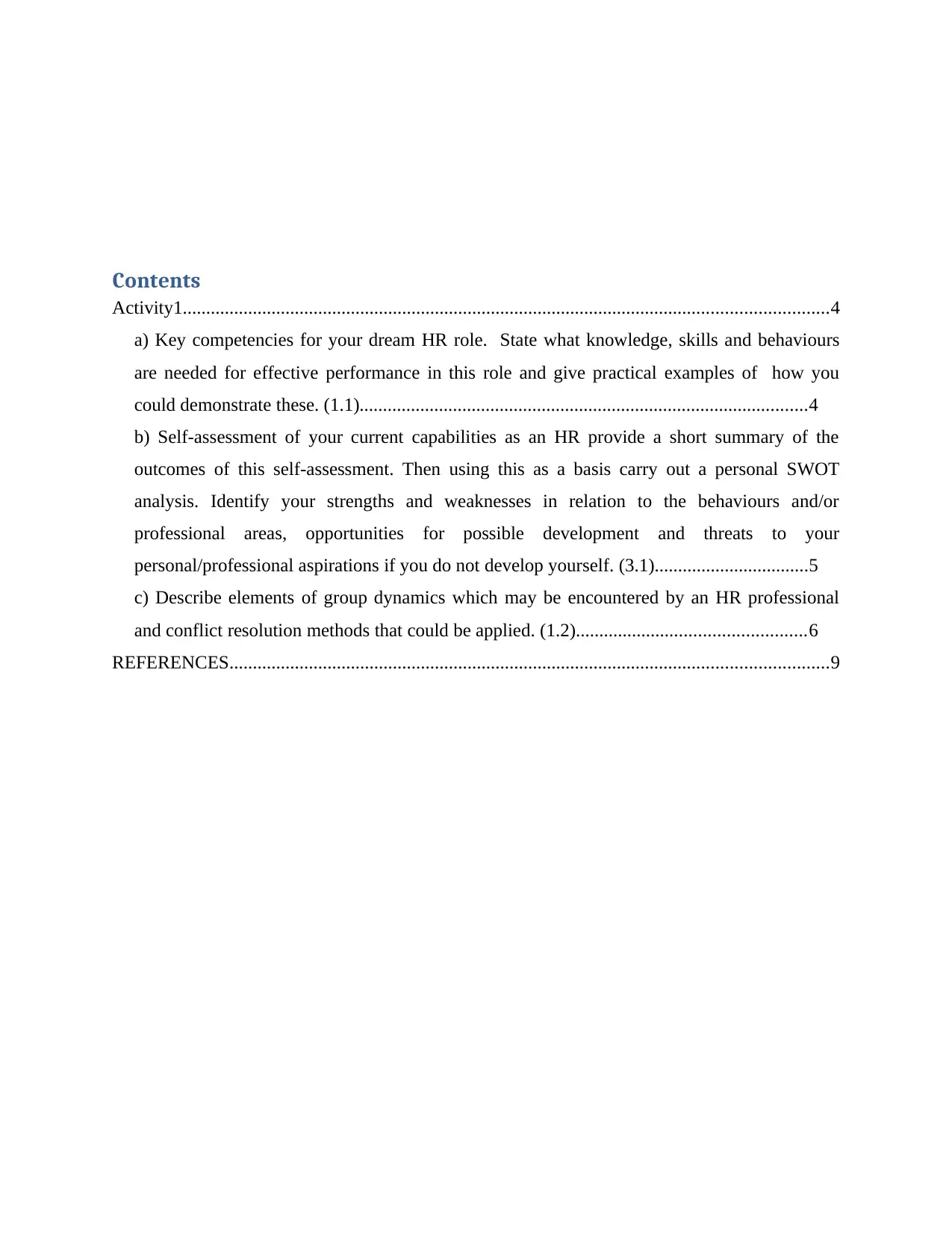
Contents
Activity1..........................................................................................................................................4
a) Key competencies for your dream HR role. State what knowledge, skills and behaviours
are needed for effective performance in this role and give practical examples of how you
could demonstrate these. (1.1)................................................................................................4
b) Self-assessment of your current capabilities as an HR provide a short summary of the
outcomes of this self-assessment. Then using this as a basis carry out a personal SWOT
analysis. Identify your strengths and weaknesses in relation to the behaviours and/or
professional areas, opportunities for possible development and threats to your
personal/professional aspirations if you do not develop yourself. (3.1).................................5
c) Describe elements of group dynamics which may be encountered by an HR professional
and conflict resolution methods that could be applied. (1.2).................................................6
REFERENCES................................................................................................................................9
Activity1..........................................................................................................................................4
a) Key competencies for your dream HR role. State what knowledge, skills and behaviours
are needed for effective performance in this role and give practical examples of how you
could demonstrate these. (1.1)................................................................................................4
b) Self-assessment of your current capabilities as an HR provide a short summary of the
outcomes of this self-assessment. Then using this as a basis carry out a personal SWOT
analysis. Identify your strengths and weaknesses in relation to the behaviours and/or
professional areas, opportunities for possible development and threats to your
personal/professional aspirations if you do not develop yourself. (3.1).................................5
c) Describe elements of group dynamics which may be encountered by an HR professional
and conflict resolution methods that could be applied. (1.2).................................................6
REFERENCES................................................................................................................................9

⊘ This is a preview!⊘
Do you want full access?
Subscribe today to unlock all pages.

Trusted by 1+ million students worldwide
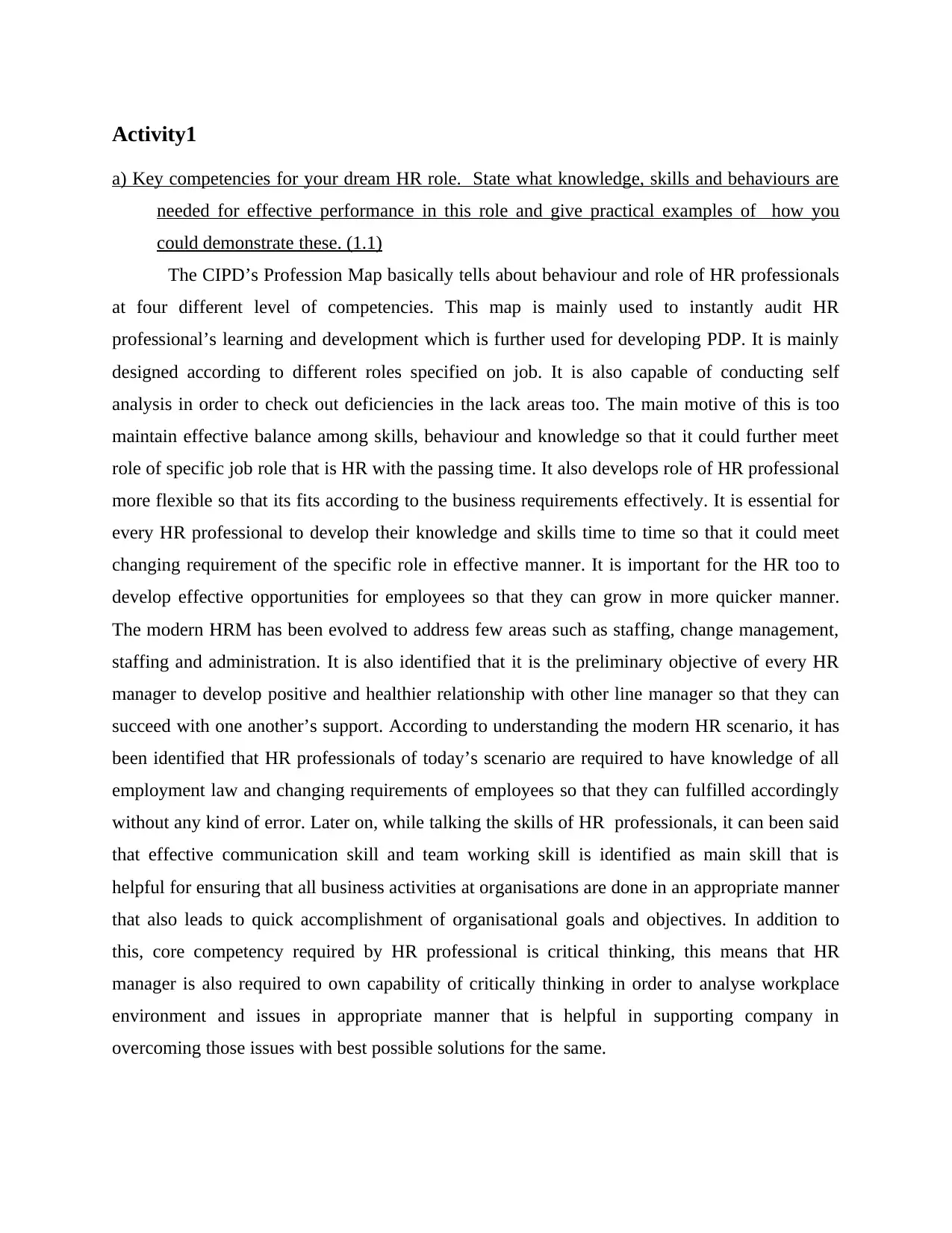
Activity1
a) Key competencies for your dream HR role. State what knowledge, skills and behaviours are
needed for effective performance in this role and give practical examples of how you
could demonstrate these. (1.1)
The CIPD’s Profession Map basically tells about behaviour and role of HR professionals
at four different level of competencies. This map is mainly used to instantly audit HR
professional’s learning and development which is further used for developing PDP. It is mainly
designed according to different roles specified on job. It is also capable of conducting self
analysis in order to check out deficiencies in the lack areas too. The main motive of this is too
maintain effective balance among skills, behaviour and knowledge so that it could further meet
role of specific job role that is HR with the passing time. It also develops role of HR professional
more flexible so that its fits according to the business requirements effectively. It is essential for
every HR professional to develop their knowledge and skills time to time so that it could meet
changing requirement of the specific role in effective manner. It is important for the HR too to
develop effective opportunities for employees so that they can grow in more quicker manner.
The modern HRM has been evolved to address few areas such as staffing, change management,
staffing and administration. It is also identified that it is the preliminary objective of every HR
manager to develop positive and healthier relationship with other line manager so that they can
succeed with one another’s support. According to understanding the modern HR scenario, it has
been identified that HR professionals of today’s scenario are required to have knowledge of all
employment law and changing requirements of employees so that they can fulfilled accordingly
without any kind of error. Later on, while talking the skills of HR professionals, it can been said
that effective communication skill and team working skill is identified as main skill that is
helpful for ensuring that all business activities at organisations are done in an appropriate manner
that also leads to quick accomplishment of organisational goals and objectives. In addition to
this, core competency required by HR professional is critical thinking, this means that HR
manager is also required to own capability of critically thinking in order to analyse workplace
environment and issues in appropriate manner that is helpful in supporting company in
overcoming those issues with best possible solutions for the same.
a) Key competencies for your dream HR role. State what knowledge, skills and behaviours are
needed for effective performance in this role and give practical examples of how you
could demonstrate these. (1.1)
The CIPD’s Profession Map basically tells about behaviour and role of HR professionals
at four different level of competencies. This map is mainly used to instantly audit HR
professional’s learning and development which is further used for developing PDP. It is mainly
designed according to different roles specified on job. It is also capable of conducting self
analysis in order to check out deficiencies in the lack areas too. The main motive of this is too
maintain effective balance among skills, behaviour and knowledge so that it could further meet
role of specific job role that is HR with the passing time. It also develops role of HR professional
more flexible so that its fits according to the business requirements effectively. It is essential for
every HR professional to develop their knowledge and skills time to time so that it could meet
changing requirement of the specific role in effective manner. It is important for the HR too to
develop effective opportunities for employees so that they can grow in more quicker manner.
The modern HRM has been evolved to address few areas such as staffing, change management,
staffing and administration. It is also identified that it is the preliminary objective of every HR
manager to develop positive and healthier relationship with other line manager so that they can
succeed with one another’s support. According to understanding the modern HR scenario, it has
been identified that HR professionals of today’s scenario are required to have knowledge of all
employment law and changing requirements of employees so that they can fulfilled accordingly
without any kind of error. Later on, while talking the skills of HR professionals, it can been said
that effective communication skill and team working skill is identified as main skill that is
helpful for ensuring that all business activities at organisations are done in an appropriate manner
that also leads to quick accomplishment of organisational goals and objectives. In addition to
this, core competency required by HR professional is critical thinking, this means that HR
manager is also required to own capability of critically thinking in order to analyse workplace
environment and issues in appropriate manner that is helpful in supporting company in
overcoming those issues with best possible solutions for the same.
Paraphrase This Document
Need a fresh take? Get an instant paraphrase of this document with our AI Paraphraser

b) Self-assessment of your current capabilities as an HR provide a short summary of the
outcomes of this self-assessment. Then using this as a basis carry out a personal SWOT
analysis. Identify your strengths and weaknesses in relation to the behaviours and/or
professional areas, opportunities for possible development and threats to your
personal/professional aspirations if you do not develop yourself. (3.1)
For enhancing capabilities of an individual working as HR professional SWOT analysis has been
described below in an effective manner so that better understanding can be developed on the
same, conducted from my own evaluation of capabilities. SWOT analysis of HR professional is
described as below:
Strength Weakness
I am good at communication skill as I am
capable of managing organisational work
effectively by convincing employees towards
the same priority. This also ensures that work
is completed at right time.
Lackness in team working skill keeps me from
accomplishing team oriented tasks. This
ultimately affects my performance and also
sometimes makes it difficult for me to execute
organisational work within the provided time
frame.
Opportunities Threat
Time management is identified as an emerging
opportunity for me in my job role as it is
mandatory for HR professionals to accomplish
all work within the stated time.
Increasing conflicts at workplace has been seen
as major threat for me as well as my profession
within the company. This is because, when
employees belonging to different culture and
background works in a company it directly
increases chances of conflict among them This
many times results in the delay in
organisational work.
On the basis of above discussion, it can be said that communication as well as critical
skills are the strengths of my personality. These provide aid to me in carrying out the roles and
responsibilities associated with my job role of HR. In addition to this, it can be acknowledged
that I am weak at collaborative working due to hesitation. There is a dire need for me to enhance
this skill of mine for better delivery of performance as an HR. Apart from this, I have enough
outcomes of this self-assessment. Then using this as a basis carry out a personal SWOT
analysis. Identify your strengths and weaknesses in relation to the behaviours and/or
professional areas, opportunities for possible development and threats to your
personal/professional aspirations if you do not develop yourself. (3.1)
For enhancing capabilities of an individual working as HR professional SWOT analysis has been
described below in an effective manner so that better understanding can be developed on the
same, conducted from my own evaluation of capabilities. SWOT analysis of HR professional is
described as below:
Strength Weakness
I am good at communication skill as I am
capable of managing organisational work
effectively by convincing employees towards
the same priority. This also ensures that work
is completed at right time.
Lackness in team working skill keeps me from
accomplishing team oriented tasks. This
ultimately affects my performance and also
sometimes makes it difficult for me to execute
organisational work within the provided time
frame.
Opportunities Threat
Time management is identified as an emerging
opportunity for me in my job role as it is
mandatory for HR professionals to accomplish
all work within the stated time.
Increasing conflicts at workplace has been seen
as major threat for me as well as my profession
within the company. This is because, when
employees belonging to different culture and
background works in a company it directly
increases chances of conflict among them This
many times results in the delay in
organisational work.
On the basis of above discussion, it can be said that communication as well as critical
skills are the strengths of my personality. These provide aid to me in carrying out the roles and
responsibilities associated with my job role of HR. In addition to this, it can be acknowledged
that I am weak at collaborative working due to hesitation. There is a dire need for me to enhance
this skill of mine for better delivery of performance as an HR. Apart from this, I have enough
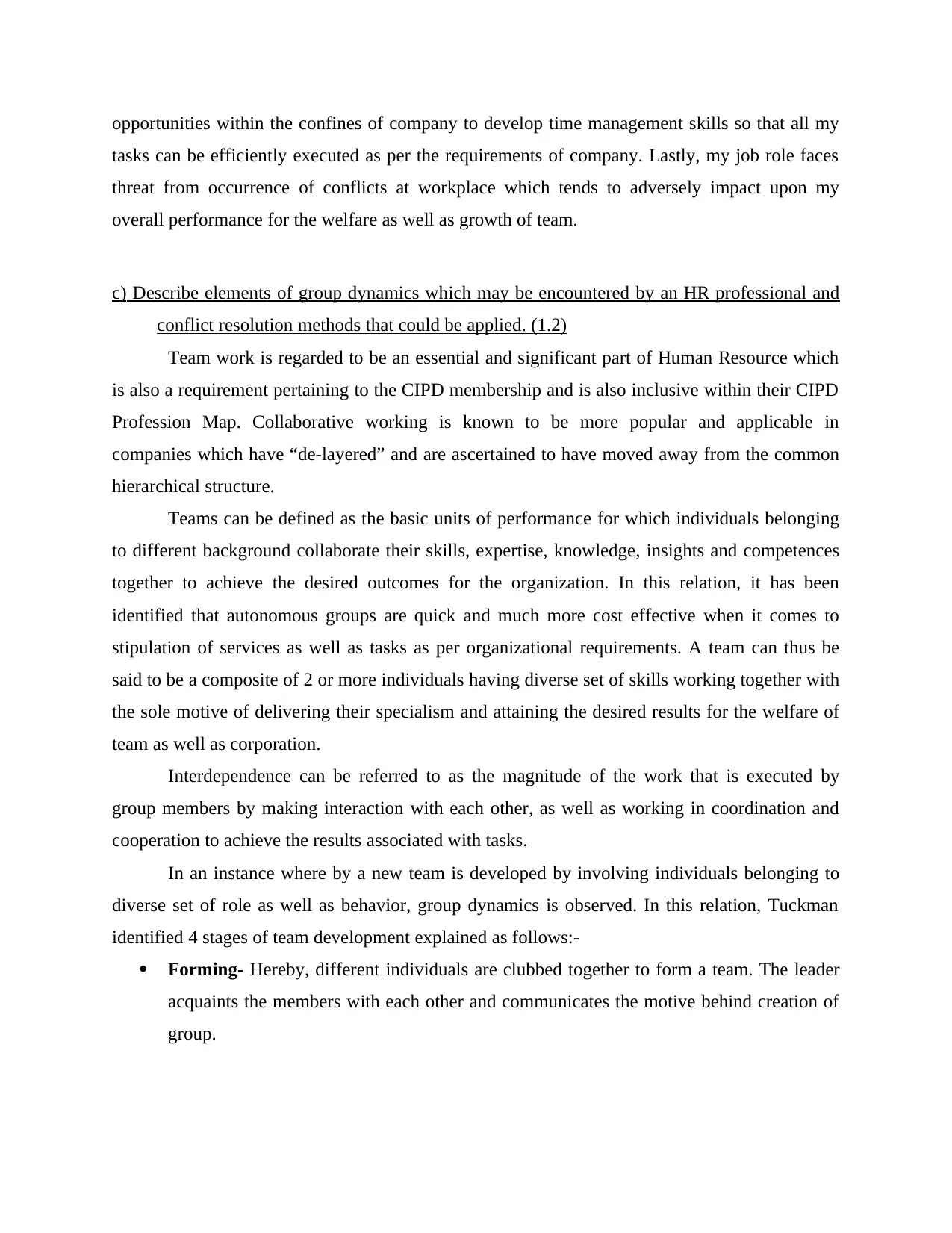
opportunities within the confines of company to develop time management skills so that all my
tasks can be efficiently executed as per the requirements of company. Lastly, my job role faces
threat from occurrence of conflicts at workplace which tends to adversely impact upon my
overall performance for the welfare as well as growth of team.
c) Describe elements of group dynamics which may be encountered by an HR professional and
conflict resolution methods that could be applied. (1.2)
Team work is regarded to be an essential and significant part of Human Resource which
is also a requirement pertaining to the CIPD membership and is also inclusive within their CIPD
Profession Map. Collaborative working is known to be more popular and applicable in
companies which have “de-layered” and are ascertained to have moved away from the common
hierarchical structure.
Teams can be defined as the basic units of performance for which individuals belonging
to different background collaborate their skills, expertise, knowledge, insights and competences
together to achieve the desired outcomes for the organization. In this relation, it has been
identified that autonomous groups are quick and much more cost effective when it comes to
stipulation of services as well as tasks as per organizational requirements. A team can thus be
said to be a composite of 2 or more individuals having diverse set of skills working together with
the sole motive of delivering their specialism and attaining the desired results for the welfare of
team as well as corporation.
Interdependence can be referred to as the magnitude of the work that is executed by
group members by making interaction with each other, as well as working in coordination and
cooperation to achieve the results associated with tasks.
In an instance where by a new team is developed by involving individuals belonging to
diverse set of role as well as behavior, group dynamics is observed. In this relation, Tuckman
identified 4 stages of team development explained as follows:-
Forming- Hereby, different individuals are clubbed together to form a team. The leader
acquaints the members with each other and communicates the motive behind creation of
group.
tasks can be efficiently executed as per the requirements of company. Lastly, my job role faces
threat from occurrence of conflicts at workplace which tends to adversely impact upon my
overall performance for the welfare as well as growth of team.
c) Describe elements of group dynamics which may be encountered by an HR professional and
conflict resolution methods that could be applied. (1.2)
Team work is regarded to be an essential and significant part of Human Resource which
is also a requirement pertaining to the CIPD membership and is also inclusive within their CIPD
Profession Map. Collaborative working is known to be more popular and applicable in
companies which have “de-layered” and are ascertained to have moved away from the common
hierarchical structure.
Teams can be defined as the basic units of performance for which individuals belonging
to different background collaborate their skills, expertise, knowledge, insights and competences
together to achieve the desired outcomes for the organization. In this relation, it has been
identified that autonomous groups are quick and much more cost effective when it comes to
stipulation of services as well as tasks as per organizational requirements. A team can thus be
said to be a composite of 2 or more individuals having diverse set of skills working together with
the sole motive of delivering their specialism and attaining the desired results for the welfare of
team as well as corporation.
Interdependence can be referred to as the magnitude of the work that is executed by
group members by making interaction with each other, as well as working in coordination and
cooperation to achieve the results associated with tasks.
In an instance where by a new team is developed by involving individuals belonging to
diverse set of role as well as behavior, group dynamics is observed. In this relation, Tuckman
identified 4 stages of team development explained as follows:-
Forming- Hereby, different individuals are clubbed together to form a team. The leader
acquaints the members with each other and communicates the motive behind creation of
group.
⊘ This is a preview!⊘
Do you want full access?
Subscribe today to unlock all pages.

Trusted by 1+ million students worldwide

Storming- Hereby, the individuals belonging to the team are acknowledged to be
resisting the leadership and recognize themselves as individual rather than a significant
part of group.
Norming- This stage marks the allotment of roles and responsibilities to different
members by the leader as per the skills, expertise and interests of members.
Performing- This is the stage which marks the actual execution of performance by the
members together by operating in coordination and cooperation with each other.
Productive arguments take pace but are resolved on a positive note.
It is later that Tuckman later added the 5th stage named 'Adjourning' to the model where
y the group is disbursed and members get back to their routine working.
Team consists of diverse set of individuals who have different strength and weakness. In
this regard, Belbin has devised a Team Role theory which consists of 9 roles that are allotted to
individuals as per their skills and personality traits. It is seen that when people belonging to
different professional and academic backgrounds come to operate as a team on a challenging task
or project, the results are usually positive. The ideas that are generated as a result of formation of
team are generally full of innovation and creativity. Members communicate with each other and
place trust in one another so that they can work together collaboratively for the long term welfare
of company.
Conflict is seen to exist amidst a group at ‘Storming’ as well as ‘Performing’ stage. It
occurs as a result of rivalry, change, frustration and compromise. The role of leader is the key
here as they are the ones who need to possess strong coaching skills with which they can train
the team effectively and ask them to focus upon productive matters only. Usually, through the
stipulation of efforts by team leader, the conflicts get resolved. However, gaining
comprehensibility of the source of conflicts is essential as this helps the leader in stipulation of
strategies for conflict resolution process to take place in an effective manner. The progress to
resolution facilitates stronger mutual respect. In an instance whereby the conflicts are not
resolved in a timely manner, it can have severe impacts upon the individual as well as
collaborative performance of the team members. Hereby, interaction acts as the key and active
listening paves way for communication to take place as per the requirements.
The PEACE Communication Model for Conflict resolution rules are:
Pick an appropriate strategy and doing preparations
resisting the leadership and recognize themselves as individual rather than a significant
part of group.
Norming- This stage marks the allotment of roles and responsibilities to different
members by the leader as per the skills, expertise and interests of members.
Performing- This is the stage which marks the actual execution of performance by the
members together by operating in coordination and cooperation with each other.
Productive arguments take pace but are resolved on a positive note.
It is later that Tuckman later added the 5th stage named 'Adjourning' to the model where
y the group is disbursed and members get back to their routine working.
Team consists of diverse set of individuals who have different strength and weakness. In
this regard, Belbin has devised a Team Role theory which consists of 9 roles that are allotted to
individuals as per their skills and personality traits. It is seen that when people belonging to
different professional and academic backgrounds come to operate as a team on a challenging task
or project, the results are usually positive. The ideas that are generated as a result of formation of
team are generally full of innovation and creativity. Members communicate with each other and
place trust in one another so that they can work together collaboratively for the long term welfare
of company.
Conflict is seen to exist amidst a group at ‘Storming’ as well as ‘Performing’ stage. It
occurs as a result of rivalry, change, frustration and compromise. The role of leader is the key
here as they are the ones who need to possess strong coaching skills with which they can train
the team effectively and ask them to focus upon productive matters only. Usually, through the
stipulation of efforts by team leader, the conflicts get resolved. However, gaining
comprehensibility of the source of conflicts is essential as this helps the leader in stipulation of
strategies for conflict resolution process to take place in an effective manner. The progress to
resolution facilitates stronger mutual respect. In an instance whereby the conflicts are not
resolved in a timely manner, it can have severe impacts upon the individual as well as
collaborative performance of the team members. Hereby, interaction acts as the key and active
listening paves way for communication to take place as per the requirements.
The PEACE Communication Model for Conflict resolution rules are:
Pick an appropriate strategy and doing preparations
Paraphrase This Document
Need a fresh take? Get an instant paraphrase of this document with our AI Paraphraser

Ensuring that voices are given ears
Attacking the issue rather than the individuals
Creation of Options by way of mind map and discussions over the time plan
Evaluation
Attacking the issue rather than the individuals
Creation of Options by way of mind map and discussions over the time plan
Evaluation
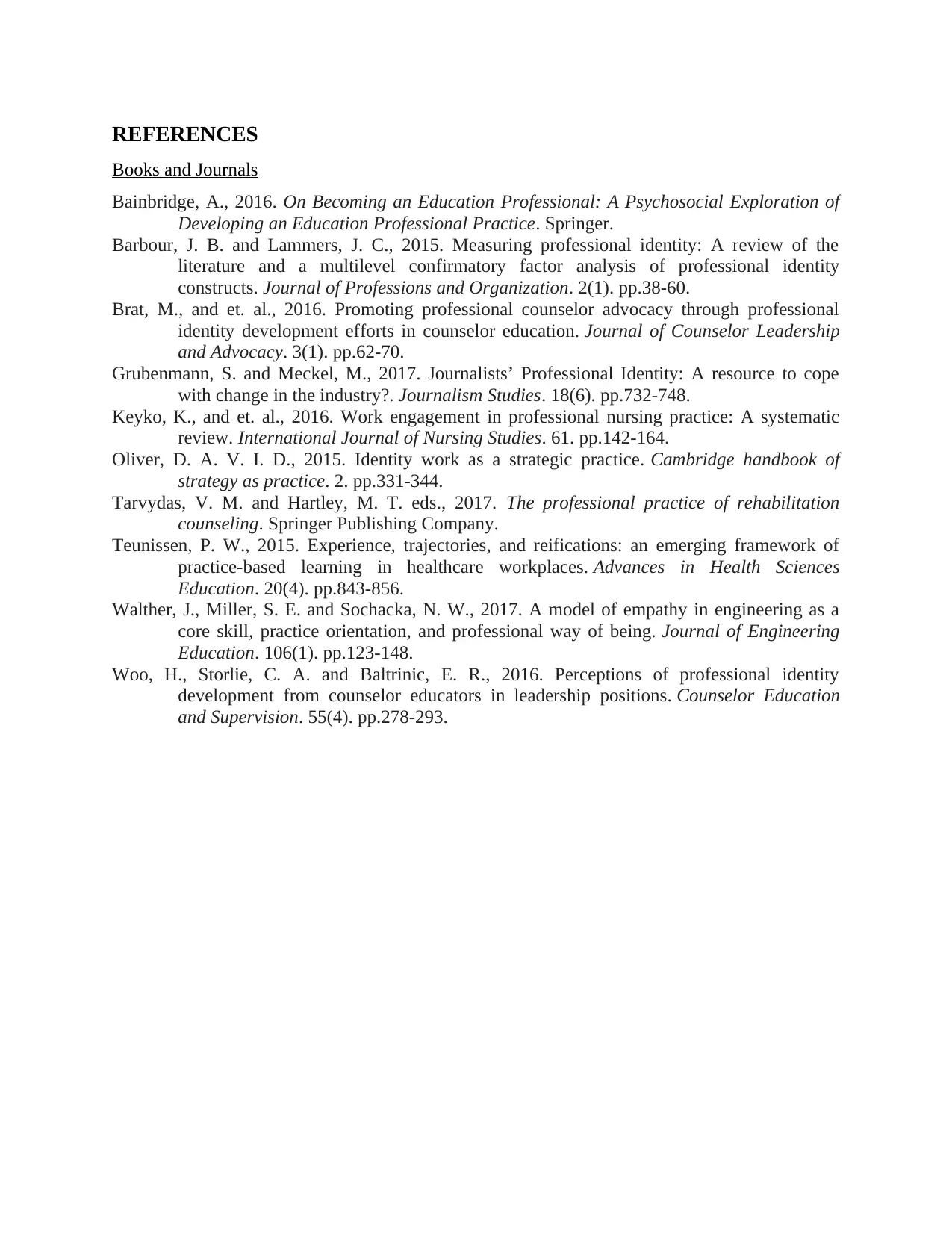
REFERENCES
Books and Journals
Bainbridge, A., 2016. On Becoming an Education Professional: A Psychosocial Exploration of
Developing an Education Professional Practice. Springer.
Barbour, J. B. and Lammers, J. C., 2015. Measuring professional identity: A review of the
literature and a multilevel confirmatory factor analysis of professional identity
constructs. Journal of Professions and Organization. 2(1). pp.38-60.
Brat, M., and et. al., 2016. Promoting professional counselor advocacy through professional
identity development efforts in counselor education. Journal of Counselor Leadership
and Advocacy. 3(1). pp.62-70.
Grubenmann, S. and Meckel, M., 2017. Journalists’ Professional Identity: A resource to cope
with change in the industry?. Journalism Studies. 18(6). pp.732-748.
Keyko, K., and et. al., 2016. Work engagement in professional nursing practice: A systematic
review. International Journal of Nursing Studies. 61. pp.142-164.
Oliver, D. A. V. I. D., 2015. Identity work as a strategic practice. Cambridge handbook of
strategy as practice. 2. pp.331-344.
Tarvydas, V. M. and Hartley, M. T. eds., 2017. The professional practice of rehabilitation
counseling. Springer Publishing Company.
Teunissen, P. W., 2015. Experience, trajectories, and reifications: an emerging framework of
practice-based learning in healthcare workplaces. Advances in Health Sciences
Education. 20(4). pp.843-856.
Walther, J., Miller, S. E. and Sochacka, N. W., 2017. A model of empathy in engineering as a
core skill, practice orientation, and professional way of being. Journal of Engineering
Education. 106(1). pp.123-148.
Woo, H., Storlie, C. A. and Baltrinic, E. R., 2016. Perceptions of professional identity
development from counselor educators in leadership positions. Counselor Education
and Supervision. 55(4). pp.278-293.
Books and Journals
Bainbridge, A., 2016. On Becoming an Education Professional: A Psychosocial Exploration of
Developing an Education Professional Practice. Springer.
Barbour, J. B. and Lammers, J. C., 2015. Measuring professional identity: A review of the
literature and a multilevel confirmatory factor analysis of professional identity
constructs. Journal of Professions and Organization. 2(1). pp.38-60.
Brat, M., and et. al., 2016. Promoting professional counselor advocacy through professional
identity development efforts in counselor education. Journal of Counselor Leadership
and Advocacy. 3(1). pp.62-70.
Grubenmann, S. and Meckel, M., 2017. Journalists’ Professional Identity: A resource to cope
with change in the industry?. Journalism Studies. 18(6). pp.732-748.
Keyko, K., and et. al., 2016. Work engagement in professional nursing practice: A systematic
review. International Journal of Nursing Studies. 61. pp.142-164.
Oliver, D. A. V. I. D., 2015. Identity work as a strategic practice. Cambridge handbook of
strategy as practice. 2. pp.331-344.
Tarvydas, V. M. and Hartley, M. T. eds., 2017. The professional practice of rehabilitation
counseling. Springer Publishing Company.
Teunissen, P. W., 2015. Experience, trajectories, and reifications: an emerging framework of
practice-based learning in healthcare workplaces. Advances in Health Sciences
Education. 20(4). pp.843-856.
Walther, J., Miller, S. E. and Sochacka, N. W., 2017. A model of empathy in engineering as a
core skill, practice orientation, and professional way of being. Journal of Engineering
Education. 106(1). pp.123-148.
Woo, H., Storlie, C. A. and Baltrinic, E. R., 2016. Perceptions of professional identity
development from counselor educators in leadership positions. Counselor Education
and Supervision. 55(4). pp.278-293.
⊘ This is a preview!⊘
Do you want full access?
Subscribe today to unlock all pages.

Trusted by 1+ million students worldwide
1 out of 9
Related Documents
Your All-in-One AI-Powered Toolkit for Academic Success.
+13062052269
info@desklib.com
Available 24*7 on WhatsApp / Email
![[object Object]](/_next/static/media/star-bottom.7253800d.svg)
Unlock your academic potential
Copyright © 2020–2025 A2Z Services. All Rights Reserved. Developed and managed by ZUCOL.




